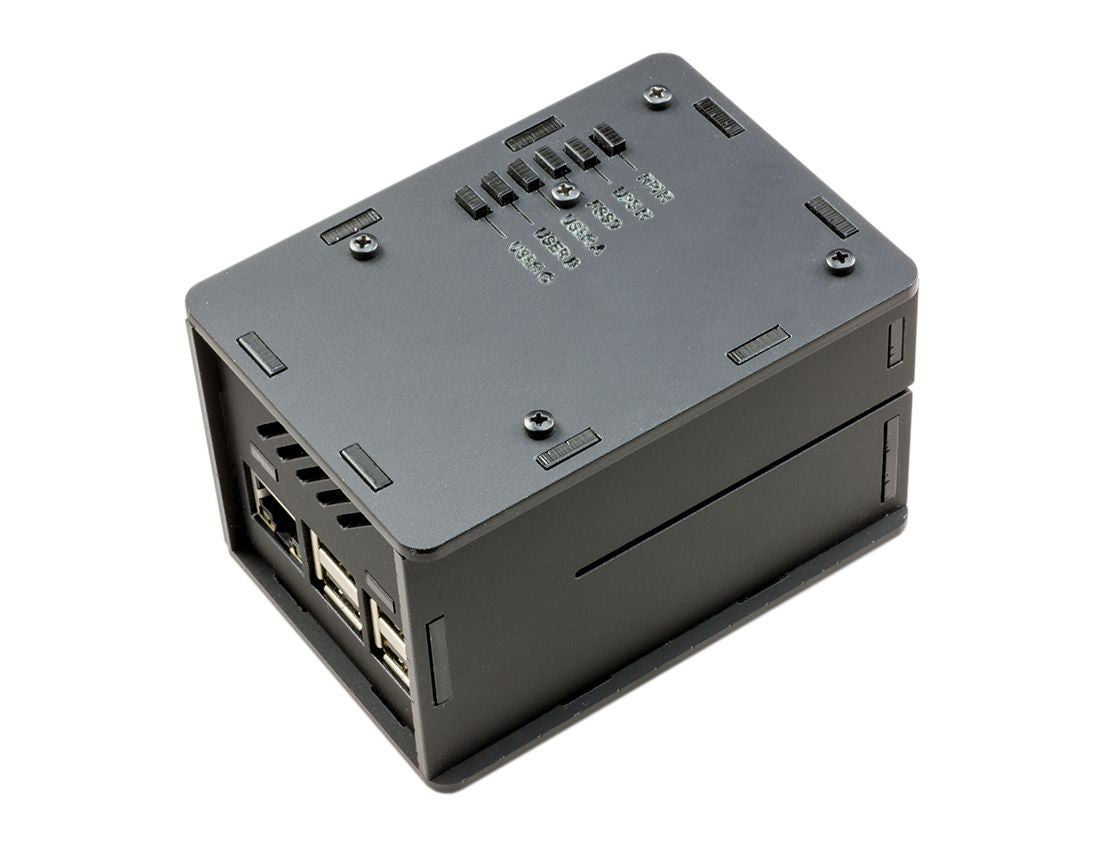
PIco UPS Cases - Standard - Assembly Instructions
The laser-cut parts of the case are protected by an adhesive film which needs to be removed before assembly.
Bill of Materials
- Raspberry Pi B+/2/3
- PIco UPS
- 14x Black Acrylic Pieces
- 2x Clear Acrylic Pieces
- 4x M2.5 x 8mm M/F Stand Off
- 5x M2.5 x 13mm F/F Stand Off
- 4x M2.5 x 11mm M/F Stand Off
- 4x M2.5 x 18mm M/F Stand Off
- 10x M2.5 Black Screw
NOTE: Acrylic is a hard and stiff plastic which is sensitive to stress concentrations and shares a certain level of fragility with glass. Acrylic can scratch easily and should be cleaned with a mild solution of dish detergent and warm water. Never use cleaners unsuitable for acrylic. Never use a dry, abrasive cloth.
Here are the parts from the case kit:

Follow these images checking parts and orientation of the acrylic pieces. You will see a before and after image for each step. Make sure you have all the parts ready, shown in the before picture.

Attach the 13mm F/F Stand Offs to the top of the Pi's mounting holes by inserting the 8mm M/F Stands Off from the bottom of the Pi.


Now we need to attach the PIco. Start by inserting the 40 pin header from the bottom of the PIco so that the pins are facing upwards.

Then attach the PIco to the Pi's GPIO header and secure in place using the 11mm M/F Stand Offs.


If you are using the Terminal Block PCB, attach this to the PIco's terminal block header and secure using two of the 18mm M/F Stand Offs. If you are not using the PCB then attach the straight clear acrylic piece.


Now we need to add the battery plate. Simply line up the speaker cut out with the speaker on the PIco, and the 6 button cut outs with the buttons. It just sits there for now, the side plates secure it in place later on.
Then added the curved clear acrylic piece and secure using the remaining two 18mm M/F Stand Offs. Make sure the clear acrylic curves out, towards the USB ports on the Pi.


Net, plug your battery in and secure to the battery plate using the self adhesive tape on the battery.


Now we are going to start adding the side plates. This can be a little fiddly and requires a bit of patience. Start with the Ethernet/USB port plate.


The the SD Card slot plate.


Then add the GPIO side plate.


And finally the USB Power/HDMI side plate.

At this point you might want to put an elastic band around the case to hold it in place.

With the bottom plate correctly aligned flat on the table. Lift the case up and place on to the bottom plate. Carefully pick the whole lot up, flip it over and secure the bottom plate with four black screws.


Attach the remianing 13mm F/F Stand Off to the button holder. Make sure you check the orientation with the pictures.


Insert each of the buttons into the button holder, making sure the little arms of the buttons are on the same side as the stand off.

Then carefully attached the stand off to the top plate. Make sure the buttons line up correctly with the holes in the top plate.



Now we need to secure the top plate to the rest of the case. This step is a bit fiddly, but with some wiggling it'll go together.
With the top of the top plate facing the table (button legs facing up), grab the whole case and flip it over on top of the top plate.
Start by aligning the two pips the side of the buttons.
Carefully wiggly the case to get all the pips around the sides to fit.


Now flip the whole lot over and secure the top plate using the remaining four black screws.









